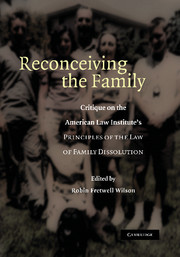 Reconceiving the Family
Reconceiving the Family Book contents
- Frontmatter
- Contents
- Acknowledgments
- Foreword, by Mary Ann Glendon
- List of Contributors
- Introduction
- PART ONE FAULT
- 1 Beyond Fault and No-Fault in the Reform of Marital Dissolution Law
- 2 A City without Duty, Fault, or Shame
- PART TWO CUSTODY
- PART THREE CHILD SUPPORT
- PART FOUR PROPERTY DIVISION
- PART FIVE SPOUSAL SUPPORT
- PART SIX DOMESTIC PARTNERSHIP
- PART SEVEN AGREEMENTS
- PART EIGHT JUDICIAL AND LEGISLATIVE PERSPECTIVES
- PART NINE INTERNATIONAL REFLECTIONS
- Afterword: Elite Principles: The ALI Proposals and the Politics of Law Reform, by Carl E. Schneider
- Index
1 - Beyond Fault and No-Fault in the Reform of Marital Dissolution Law
Published online by Cambridge University Press: 25 January 2010
- Frontmatter
- Contents
- Acknowledgments
- Foreword, by Mary Ann Glendon
- List of Contributors
- Introduction
- PART ONE FAULT
- 1 Beyond Fault and No-Fault in the Reform of Marital Dissolution Law
- 2 A City without Duty, Fault, or Shame
- PART TWO CUSTODY
- PART THREE CHILD SUPPORT
- PART FOUR PROPERTY DIVISION
- PART FIVE SPOUSAL SUPPORT
- PART SIX DOMESTIC PARTNERSHIP
- PART SEVEN AGREEMENTS
- PART EIGHT JUDICIAL AND LEGISLATIVE PERSPECTIVES
- PART NINE INTERNATIONAL REFLECTIONS
- Afterword: Elite Principles: The ALI Proposals and the Politics of Law Reform, by Carl E. Schneider
- Index
Summary
For such a massive production, there are surprising gaps in the Principles. Some of the most curious of these occur in Chapter 1. The ALI's vigorous repudiation of “fault” as a valid principle to be applied at dissolution and dissolution-related issues occupies the largest portion of Chapter 1. Yet there is no discussion or consideration of the numerous recently developed, ameliorative procedures and programs in marital dissolution cases. These two inconsistent decisions are in fact related to each other, reflecting a decades-old and perhaps worn-out generational perspective favoring the elimination of all obstacles, especially moral condemnation or social disapproval, to the exercise of individual autonomy in exiting marriage.
This chapter examines “fault” and “no-fault” in marital dissolution conceptually (asking whether “fault” is relevant to marital dissolution), jurisprudentially (asking how well the notions of “fault” and “no-fault” fit the premises of our legal system), and practically (asking whether rigid no-fault rules reflect the concerns of litigants in dissolution proceedings). Part I of this chapter reviews the discussion in the Principles of marital misconduct, identifies several specific and general flaws, and argues that the “fault/no-fault” language utilized in the Principles is dated, distorting, and inadequate conceptually as well as practically. It proposes that the language of accountability and responsibility be substituted for “fault” and “no-fault.”
Part II of this chapter suggests that society, families, and individuals, including divorcing parties, have compelling interests in promoting alternatives to divorce, and that such policies can be implemented as a part of marital dissolution proceedings, without severely restricting access to divorce.
- Type
- Chapter
- Information
- Reconceiving the FamilyCritique on the American Law Institute's Principles of the Law of Family Dissolution, pp. 9 - 27Publisher: Cambridge University PressPrint publication year: 2006
- 1
- Cited by
